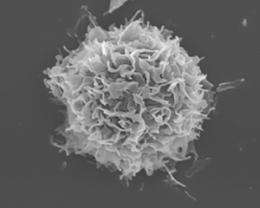Recently uncovered human counterparts to a subset of mouse immune cells may enable better vaccination strategies

Mice have made an immeasurable contribution to medicine and our overall understanding of human disease. This animal model is not without its limitations, however, and scientists are continually learning about important ways in which mouse and human biology differ.
Both human and murine immune systems, for example, function in a similar fashion, but individual subtypes of human immune cells often display characteristics unlike those of their mouse counterparts. These differences make it difficult to directly translate mouse data into medically meaningful results. By identifying parallels between a crucial class of immune cells in mice and humans, a team led by Florent Ginhoux of the A*STAR Singapore Immunology Network has obtained valuable insights that should accelerate this translation.
Cells known as dendritic cells (DCs) are at the immune frontline, capturing pathogen-derived antigens and training other immune cells known as cytotoxic T cells to recognize them via a process called 'cross-presentation'. "This is very important, as it is the only way DCs can present tumor-derived antigens or viral antigens without being a tumor cell or directly infected by a virus," explains Ginhoux. "And, it has important implications for vaccine design, where you want to get a good cytotoxic T cell response."
A subset of DCs found within the murine skin plays a particularly prominent role in this process, but equivalent cells have not yet been identified in humans. DC subsets that look similar but function differently from each other can be distinguished via distinct combinations of surface proteins that act as a 'name tag'. Through careful analysis, Ginhoux and his co-workers isolated and characterized a population of skin cells that express high levels of the protein CD141, which effectively tags this human DC subset.
The researchers determined that these skin DCs indeed possess the cellular machinery needed for cross-presentation. Ginhoux believes they should offer a useful tool for training the immune system to fight disease. "Now that we know that this population exists, our aim is to understand how to mobilize it, activate it and to target it with adjuvants and antigens relevant for vaccination," he says. In the process of characterizing these cells, the researchers also succeeded in profiling the expression of various 'name tag' proteins. From these profiles, they can draw parallels between equivalent DC subsets in mice and humans, building a valuable informational resource for future research. "This will allow clear inferences to be made between mice and humans," says Ginhoux.
More information: Haniffa, M., Shin, A., Bigley, V., McGovern, N., Teo, P. et al. Human tissues contain CD141hi cross-presenting dendritic cells with functional homology to mouse CD103+ nonlymphoid dendritic cells. Immunity 37, 60–73 (2012). dx.doi.org/10.1016/j.immuni.2012.04.012















